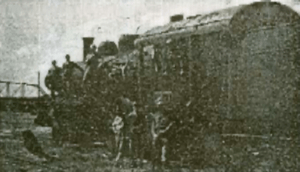Sentetsu Amei-class locomotives
| Chosen Government Railway Amei class (アメイ) Korean National Railroad Ame1 class (아메1) | |||||||||||||||||||||||||||||||||||||||||||||||
|---|---|---|---|---|---|---|---|---|---|---|---|---|---|---|---|---|---|---|---|---|---|---|---|---|---|---|---|---|---|---|---|---|---|---|---|---|---|---|---|---|---|---|---|---|---|---|---|
 An Amei-class locomotive of Sentetsu. | |||||||||||||||||||||||||||||||||||||||||||||||
| |||||||||||||||||||||||||||||||||||||||||||||||
| |||||||||||||||||||||||||||||||||||||||||||||||
| |||||||||||||||||||||||||||||||||||||||||||||||
| |||||||||||||||||||||||||||||||||||||||||||||||
The Amei class (アメイ) was a class of steam tender locomotives of the Chosen Government Railway (Sentetsu) with 4-4-0 wheel arrangement.[1] The "Ame" name came from the American naming system for steam locomotives, under which locomotives with 4-4-0 wheel arrangement were called "American".[2]
Description
Sentetsu introduced the Amei class locomotives in 1911, receiving six from ALCo of the United States. They were fitted with 1,830 mm (72 in) diameter driving wheels, which was a considerable size for the time, giving them a high operational speeds of 95 km/h (59 mph).[1] Unlike the Tehoi class locomotives, the Amei class were equipped with a four-axle tender. They were found to offer no advantage over the Teho types or Sorii class, and no further 4-4-0 locomotives were ever ordered by Sentetsu.
Sentetsu put them into service on the "Ryūki" express,[1] Korea's first express train, operating between Sinuiju and Busan via Gyeongseong,[3] along the Gyeongui Line between Sinuiju and Gyeongseong. Their original numbers are unknown, but they were numbered 401 through 406 in 1918, and then became アメイ1 through アメイ6 numbers in Sentetsu's general renumbering of 1938.
Postwar: Korean National Railroad 아메1 (Ame1) class
After the Liberation of Korea, all six Amei-class locomotives remained in South Korea, where they were designated 아메1 class by the Korean National Railroad.[4]
Construction
| Sentetsu running number | ||||||
|---|---|---|---|---|---|---|
| 1911–1918 | 1918–1938 | 1938–1945 | KNR Number | Builder | Year | Notes |
| ? | アメ401 | アメイ1 | 아메1-1 | ALCo | 1911 | |
| ? | アメ402 | アメイ2 | 아메1-2 | ALCo | 1911 | |
| ? | アメ403 | アメイ3 | 아메1-3 | ALCo | 1911 | |
| ? | アメ404 | アメイ4 | 아메1-4 | ALCo | 1911 | |
| ? | アメ405 | アメイ5 | 아메1-5 | ALCo | 1911 | |
| ? | アメ406 | アメイ6 | 아메1-6 | ALCo | 1911 | |
References
- 1 2 3 Byeon, Seong-u (1999). 한국철도차량 100년사 [Korean Railways Rolling Stock Centennial] (in Korean). Seoul: Korea Rolling Stock Technical Corp.
- ↑ Colvin, Fred H. (1906). The railroad pocket-book: a quick reference cyclopedia of railroad information. New York, Derry-Collard; London, Locomotive Publishing Company (US-UK co-edition). p. L‑9.
- ↑ Japanese Government Railways (1937), 鉄道停車場一覧. 昭和12年10月1日現在(The List of the Stations as of 1 October 1937), Kawaguchi Printing Company, Tokyo, pp. 483-485
- ↑ "North and South Korea Steam Locomotives". 20 April 2004. Archived from the original on 20 April 2004.